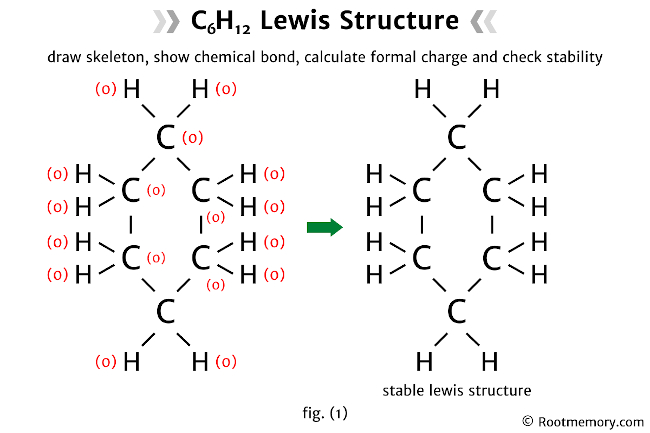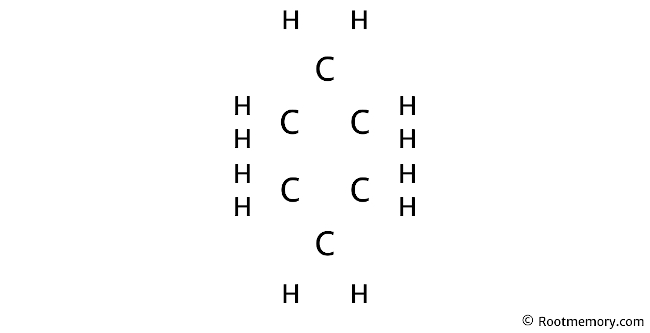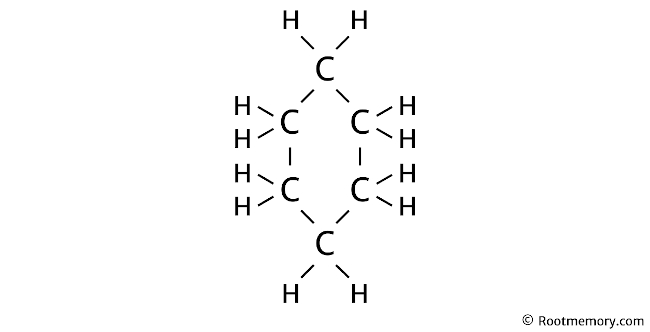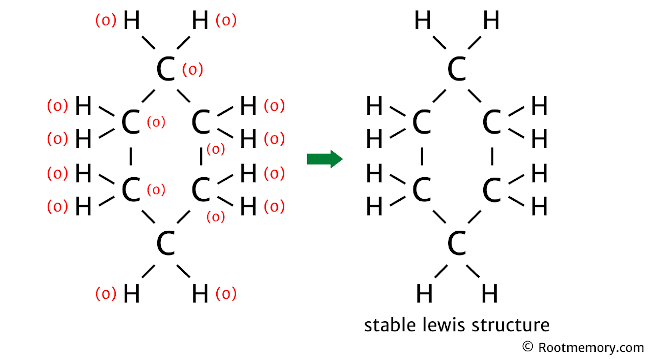
The Lewis structure of C6H12 contains eighteen single bonds, with six carbons in the center, and each carbon is attached with two hydrogens. Both hydrogen atom and carbon atom do not have any lone pair.
Alternative method: C6H12 Lewis structure
Steps
Draw skeleton
In this step, first calculate the total number of valence electrons. And then, decide the central atom.
- Let’s calculate the total number of valence electrons
We know that… carbon is a group 14 element and hydrogen is a group 1 element. Hence, carbon has four valence electrons and hydrogen has one valence electron.
Now C6H12 has six carbon atoms and twelve hydrogen atoms.
So the total number of valence electrons = (valence electrons of carbon atom × 6) + (valence electrons of hydrogen atom × 12)
Therefore, the total number of valence electrons = 24 + 12 = 36
- Now decide the central atom
We can not assume hydrogen as the central atom, because the central atom is bonded with at least two other atoms. And hydrogen has only one electron in its last shell, so it can not make more than one bond.
Therefore, choose carbon as the central atom.
But there are six carbon atoms in C6H12. Hence, we can assume any one as the central atom. Let’s assume that top carbon is the central atom.
So now, put six carbons in the center and twelve hydrogens on either side. And draw the rough skeleton structure for the Lewis structure of C6H12 something like this:

Also read: How to draw Lewis structure of POF3 (5 steps)
Show chemical bond
Place two electrons between the atoms to show a chemical bond. Since six carbons are surrounded by twelve hydrogens, use thirty-six electrons to show eighteen chemical bonds as follows:

In the above structure, you can see that the octet is completed on the central atom (top carbon), and also on the outside atoms. Therefore, the octet rule is satisfied.
After completing the octet, one last thing we need to do is, calculate the formal charge and check the stability of the above structure.
Also read: How to draw Lewis structure of H3PO3 (5 steps)
Calculate formal charge and check stability
The following formula is used to calculate the formal charges on atoms:
Formal charge = valence electrons – nonbonding electrons – ½ bonding electrons
Collect the data from the above structure and then, write it down below as follows:
- For each carbon atom
Valence electrons = 4
Nonbonding electrons = 0
Bonding electrons = 8
Formal charge = 4 – 0 – ½ (8) = 0
- For each hydrogen atom
Valence electrons = 1
Nonbonding electrons = 0
Bonding electrons = 2
Formal charge = 1 – 0 – ½ (2) = 0
Mention the formal charges of atoms on the structure. So the Lewis structure of C6H12 looks something like this:

In the above structure, you can see that the formal charges of both (carbon and hydrogen) are zero. Therefore, this is the stable Lewis structure of C6H12.
And each horizontal line drawn in the above structure represents a pair of bonding valence electrons.
Next: Lewis structure of POF3
Related
- Lewis structure of POF3
- Lewis structure of H3PO3
- Lewis structure of CF3Cl
- Lewis structure of XeCl3–
- Lewis structure of XeF3–
External video
- C6H12 Lewis Structure: How to Draw the Lewis Structure for Cyclohexane – YouTube • Wayne Breslyn
External links
- Chemical Bonding: C6H12 Lewis Structure – The Geoexchange
- C6H12 lewis structure, molecular geometry, hybridization, bond angle – Topblogtenz
- Cyclohexane | C6H12 | CID 8078 – National Institutes of Health (.gov)
- Below is the Lewis structure of cyclohexane (C6H12) – Chegg
- Dot structure for covalent bond C6H12? – Answers
- Below is the Lewis structure of cyclohexane (C6H12) molecule – OneClass
- What do the skeletal structures of C6H12 look like? – Socratic
- Cyclohexane | Formula, Structure & Density – Study.com
- What is the lewis and lewis dot structure for hexene? – Numerade
- Structural isomers of molecular formula C6H12 – Doc Brown’s Chemistry
Deep
Rootmemory.com was founded by Deep Rana, who is a mechanical engineer by profession and a blogger by passion. He has a good conceptual knowledge on different educational topics and he provides the same on this website. He loves to learn something new everyday and believes that the best utilization of free time is developing a new skill.
